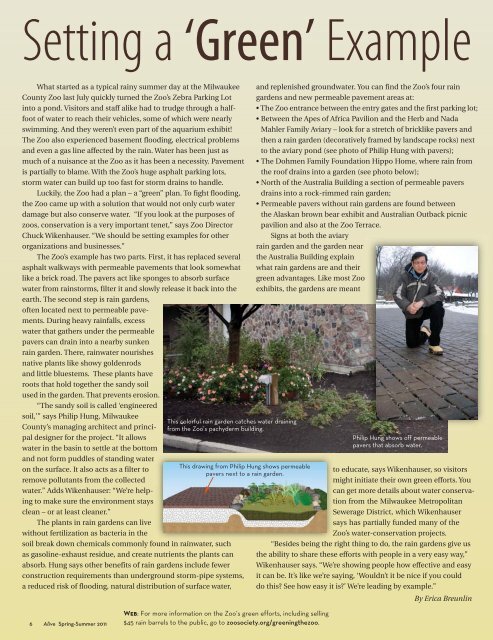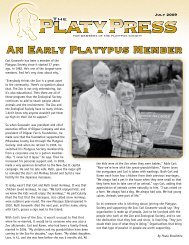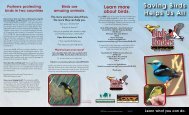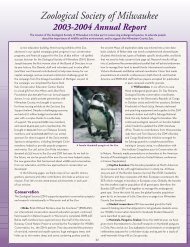Bonobo - Zoological Society of Milwaukee
Bonobo - Zoological Society of Milwaukee
Bonobo - Zoological Society of Milwaukee
Create successful ePaper yourself
Turn your PDF publications into a flip-book with our unique Google optimized e-Paper software.
Setting a ‘Green’ Example<br />
What started as a typical rainy summer day at the <strong>Milwaukee</strong><br />
County Zoo last July quickly turned the Zoo’s Zebra Parking Lot<br />
into a pond. Visitors and staff alike had to trudge through a halffoot<br />
<strong>of</strong> water to reach their vehicles, some <strong>of</strong> which were nearly<br />
swimming. And they weren’t even part <strong>of</strong> the aquarium exhibit!<br />
The Zoo also experienced basement flooding, electrical problems<br />
and even a gas line affected by the rain. Water has been just as<br />
much <strong>of</strong> a nuisance at the Zoo as it has been a necessity. Pavement<br />
is partially to blame. With the Zoo’s huge asphalt parking lots,<br />
storm water can build up too fast for storm drains to handle.<br />
Luckily, the Zoo had a plan – a “green” plan. To fight flooding,<br />
the Zoo came up with a solution that would not only curb water<br />
damage but also conserve water. “If you look at the purposes <strong>of</strong><br />
zoos, conservation is a very important tenet,” says Zoo Director<br />
Chuck Wikenhauser. “We should be setting examples for other<br />
organizations and businesses.”<br />
The Zoo’s example has two parts. First, it has replaced several<br />
asphalt walkways with permeable pavements that look somewhat<br />
like a brick road. The pavers act like sponges to absorb surface<br />
water from rainstorms, filter it and slowly release it back into the<br />
earth. The second step is rain gardens,<br />
<strong>of</strong>ten located next to permeable pavements.<br />
During heavy rainfalls, excess<br />
water that gathers under the permeable<br />
pavers can drain into a nearby sunken<br />
rain garden. There, rainwater nourishes<br />
native plants like showy goldenrods<br />
and little bluestems. These plants have<br />
roots that hold together the sandy soil<br />
used in the garden. That prevents erosion.<br />
“The sandy soil is called ‘engineered<br />
soil,’” says Philip Hung, <strong>Milwaukee</strong><br />
County’s managing architect and principal<br />
designer for the project. “It allows<br />
water in the basin to settle at the bottom<br />
and not form puddles <strong>of</strong> standing water<br />
on the surface. It also acts as a filter to<br />
remove pollutants from the collected<br />
water.” Adds Wikenhauser: “We’re helping<br />
to make sure the environment stays<br />
clean – or at least cleaner.”<br />
The plants in rain gardens can live<br />
without fertilization as bacteria in the<br />
soil break down chemicals commonly found in rainwater, such<br />
as gasoline-exhaust residue, and create nutrients the plants can<br />
absorb. Hung says other benefits <strong>of</strong> rain gardens include fewer<br />
construction requirements than underground storm-pipe systems,<br />
a reduced risk <strong>of</strong> flooding, natural distribution <strong>of</strong> surface water,<br />
6 Alive Spring-Summer 2011<br />
This colorful rain garden catches water draining<br />
from the Zoo’s pachyderm building.<br />
This drawing from Philip Hung shows permeable<br />
pavers next to a rain garden.<br />
Web: For more information on the Zoo’s green efforts, including selling<br />
$45 rain barrels to the public, go to zoosociety.org/greeningthezoo.<br />
and replenished groundwater. You can find the Zoo’s four rain<br />
gardens and new permeable pavement areas at:<br />
The Zoo entrance between the entry gates and the first parking lot;<br />
Between the Apes <strong>of</strong> Africa Pavilion and the Herb and Nada<br />
Mahler Family Aviary – look for a stretch <strong>of</strong> bricklike pavers and<br />
then a rain garden (decoratively framed by landscape rocks) next<br />
to the aviary pond (see photo <strong>of</strong> Philip Hung with pavers);<br />
The Dohmen Family Foundation Hippo Home, where rain from<br />
the ro<strong>of</strong> drains into a garden (see photo below);<br />
North <strong>of</strong> the Australia Building a section <strong>of</strong> permeable pavers<br />
drains into a rock-rimmed rain garden;<br />
Permeable pavers without rain gardens are found between<br />
the Alaskan brown bear exhibit and Australian Outback picnic<br />
pavilion and also at the Zoo Terrace.<br />
Signs at both the aviary<br />
rain garden and the garden near<br />
the Australia Building explain<br />
what rain gardens are and their<br />
green advantages. Like most Zoo<br />
exhibits, the gardens are meant<br />
Philip Hung shows <strong>of</strong>f permeable<br />
pavers that absorb water.<br />
to educate, says Wikenhauser, so visitors<br />
might initiate their own green efforts. You<br />
can get more details about water conservation<br />
from the <strong>Milwaukee</strong> Metropolitan<br />
Sewerage District, which Wikenhauser<br />
says has partially funded many <strong>of</strong> the<br />
Zoo’s water-conservation projects.<br />
“Besides being the right thing to do, the rain gardens give us<br />
the ability to share these efforts with people in a very easy way,”<br />
Wikenhauser says. “We’re showing people how effective and easy<br />
it can be. It’s like we’re saying, ‘Wouldn’t it be nice if you could<br />
do this? See how easy it is?’ We’re leading by example.”<br />
By Erica Breunlin













